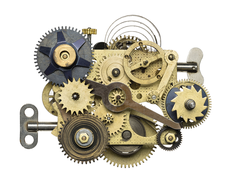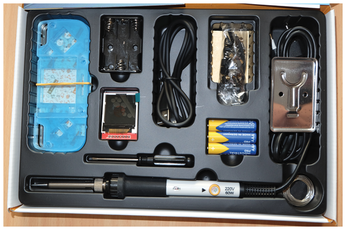Easy entry to microcontroller programming
Microcontrollers for Beginners

© Lead Image © donatas1205, 123RF.com
The Nibble kit by CircuitMess is a freely programmable mobile game console that makes getting started with microcontroller programming a breeze.
The Nibble kit by CircuitMess [1] comes with everything you need to build a portable game console. It even includes a soldering iron to solder the buttons. The lead-free solder included in the kit will easily last for several more projects. The kit also includes a simple screwdriver for assembling the case, and you won't hear this very often: The batteries are included (Figure 1).

The kit is suitable for children from nine years up, but as my test shows, older users can have fun with the kit, as well. The very detailed and easy-to-understand instructions explain all the build actions step by step. In some places, links to online videos lend further help. The assembly instructions are available for download on the manufacturer's site in several languages [2]. The Nibble kit helps users acquire a number of skills, starting with the simple act of assembling the housing, to soldering, to programming the microcontroller in C.
[...]
Buy this article as PDF
(incl. VAT)
Buy Linux Magazine
Subscribe to our Linux Newsletters
Find Linux and Open Source Jobs
Subscribe to our ADMIN Newsletters
Support Our Work
Linux Magazine content is made possible with support from readers like you. Please consider contributing when you’ve found an article to be beneficial.

News
-
Fedora 43 Has Finally Landed
The Fedora Linux developers have announced their latest release, Fedora 43.
-
KDE Unleashes Plasma 6.5
The Plasma 6.5 desktop environment is now available with new features, improvements, and the usual bug fixes.
-
Xubuntu Site Possibly Hacked
It appears that the Xubuntu site was hacked and briefly served up a malicious ZIP file from its download page.
-
LMDE 7 Now Available
Linux Mint Debian Edition, version 7, has been officially released and is based on upstream Debian.
-
Linux Kernel 6.16 Reaches EOL
Linux kernel 6.16 has reached its end of life, which means you'll need to upgrade to the next stable release, Linux kernel 6.17.
-
Amazon Ditches Android for a Linux-Based OS
Amazon has migrated from Android to the Linux-based Vega OS for its Fire TV.
-
Cairo Dock 3.6 Now Available for More Compositors
If you're a fan of third-party desktop docks, then the latest release of Cairo Dock with Wayland support is for you.
-
System76 Unleashes Pop!_OS 24.04 Beta
System76's first beta of Pop!_OS 24.04 is an impressive feat.
-
Linux Kernel 6.17 is Available
Linus Torvalds has announced that the latest kernel has been released with plenty of core improvements and even more hardware support.
-
Kali Linux 2025.3 Released with New Hacking Tools
If you're a Kali Linux fan, you'll be glad to know that the third release of this famous pen-testing distribution is now available with updates for key components.

